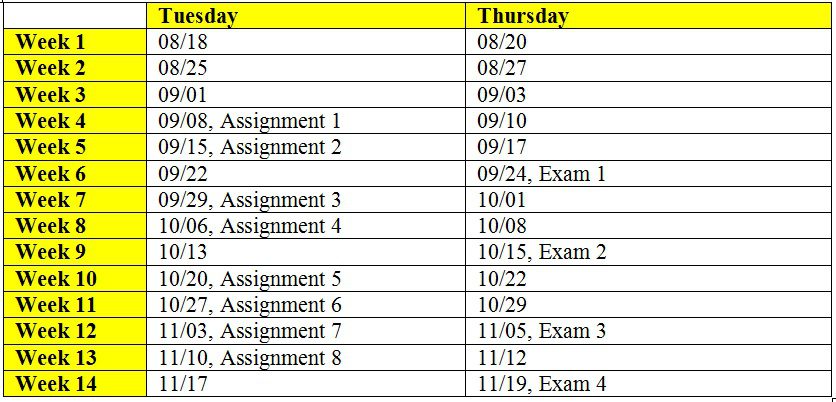Assignments 1, 2 and Exam 1 posted.
Syllabus
Landrie Tchakoua
Zoom (Meeting ID: 816 538 7125)
Tuesday 10 AM to 12 PM
Wednesday 12 PM to 4 PM
Thursday 10 AM to 12 PM; 4 PM to 6 PM
Oluwaseun Akintade
Google Meet Link: https://meet.google.com/jqv-druy-njz (Links to an external site.)
Monday 12 PM to 6 PM
Wednesday 11 AM to 3 PM
Friday 1 PM to 5 PM
Lecture Slides
Module 1: Algorithm Efficiency Analysis
Sample C++ Code and Explanation on dynamically creating and using a two-dimensional array
Module 7: P, NP, NP-Complete Problems
Question Bank
Classical Design Techniques (includes Divide and Conquer, Binary Search)
Assignments
Assignment 1: Brute Force Algorithm for the Element Uniqueness Problem, Due: Sept. 8th, 11.59 PM
Check Canvas for Code
Exams
Exam 1 (covers Modules 1 and 2); Due by Sept. 24th, 11.59 PM
Dr. Meg’s Desktop Selected Lecture Videos (YouTube Links)
Analyzing the Efficiency of Algorithms
Time-Complexity analysis of a recursive algorithm to compute the factorial of an integer
Example for solving recurrence relations
Time-complexity analysis of an iterative algorithm to determine whether an array has unique elements
Decrease and Conquer – Insertion Sort Algorithm and Examples
Classical Algorithm Design Techniuqes
Brute Force Algorithms QB – String Matching Problems
Divide and Conquer – Theorem-Proof: In order Traversal of a Binary Search Tree
Divide and Conquer – Master Theorem
Binary Search Algorithm and Examples
Comparison of Bottom-up and Top-down Approaches for Heap Construction
Transform and Conquer – Proof for Euclid’s GCD Formula
Transform and Conquer – Heap Sort
Space-Time Tradeoffs for the Sorting Algorithms (Merge, Insertion and Heap Sorts)
Greedy Technique
Greedy Technique – Fractional Knapsack Problem
Greedy Technique – Huffman Codes (Variable Length Prefix-free Encoding)
Dynamic Programming
Dynamic Programming: Coin-row Problem Discussion and Example
Dynamic Programming: Binomial Coefficient
Dynamic Programming Solution for the Coin Collecting Problem in a Two-Dimensional Grid
Dynamic Programming: Integer Knapsack Problem (0-1 Knapsack Problem)
Graph Theory Algorithms
Depth First Search on Directed Graph
Depth First Search and Articulation Points
Breadth First Search and 2-Colorability of Graphs
Topological Sort on DAGs and Proof for Neccessary and Sufficient Condition
Dijkstra’s Algorithm for Shortest Path Trees and Proof for Correctness
Bellman-Ford Algorithm for Shortest Path Trees and Examples New!!
Kruskal’s Algorithm: Examples to find Minimum Spanning Trees
Kruskal’s Algorithm: Proof of Correctness
Properties (1 and 2) of Minimum Spanning Tree: IJ-Cut and Minimum Weight Edge
Prim’s Algorithm for Minimum Spanning Trees and Proof for Correctness
Floyd’s All Pairs Shortest Paths Algorithm
Part 1 Part 2 Part 3 Part 4 Part 5 Part 6 Part 7
P, NP and NP-Complete Problems
Polynomial Reduction: Hamiltonian Circuit to Traveling Salesman Problem
Polynomial Reductions: Independent Set, Clique and Vertex Cover
Multi-fragment Heuristic for the Traveling Salesman Problem

